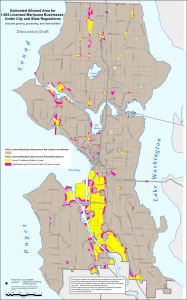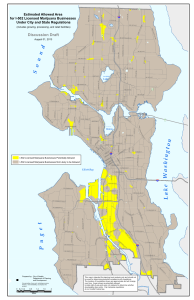by Dominic Corva, Executive Director
NOTE: Zoning maps are estimates and not final, at this point — except the second map, which was viable about a week.
Estimated Area for I502 Licensed MAP Marijuana under City and State Restrictions
Map of Common Path of Travel Analysis
Last week, the Washington State Liquor Control Board (LCB) had to take back a proposed zoning language revision for the 1000-foot rule. This revision would have defined 1000 feet from “as the crow flies” to “common path of travel,” a change that gave the second map of possible cannabis industrial location above some breathing room compared with the first map. Take a look.
The re-revision gives us some idea of just how restrictive the zoning regulations will be for Washington’s most cannabis-friendly polity. This regulatory “barrier to entry” will drive differential land prices in the City, raising alarm bells for the Port of Seattle whose summer efforts to exclude cannabis-related businesses from industrial Port spaces has culminated, for now, in a compromise whereby IG1 (the part closest to downtown, including much of SoDo) is scheduled to zone 10,000 square feet instead of 50,000 originally planned. IG2 is also revised down to 20,000 square feet.
Under the current rules, the rest of the state may permit up to 30,000 square feet. Whether they do so or not, increasing urban land prices and restricted producer space (processor space is not necessarily a problem) make it more cost-effective, once political zoning regs are relaxed in the rest of the state, to locate in rural areas. The future of cannabis agriculture, in terms of production cost, is rural hybrid greenhouses that use supplemental lighting. That model, in Israel, is currently producing 4-5 cycles per year at 50 cents a gram.
Currently, however, uncertainty about local municipal authority politics limiting 502 production outside of Seattle/King County will drive a real estate bubble centered in the most contiguous yellow space shown in the first map, south of downtown. This uncertainty, in my opinion, is easily managed by access to policymaker education and interest in getting a piece of the cannabusiness pie.
If you are a rural farmer/grower, right now is a good time to get ahead of the curve. Your land costs are way cheaper and your cost of production, with the right guidance, are way lower. The first thing to do, however, is to reach out to local authorities — policymakers and police — to discuss their attitudes towards 502. Get to know your neighbors, be a good citizen, do everything by the books, give back to your communities, and you’ll find that this is the best no-cost way to mitigate risk.
